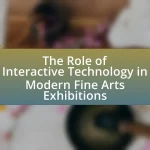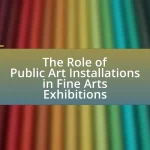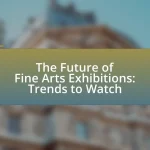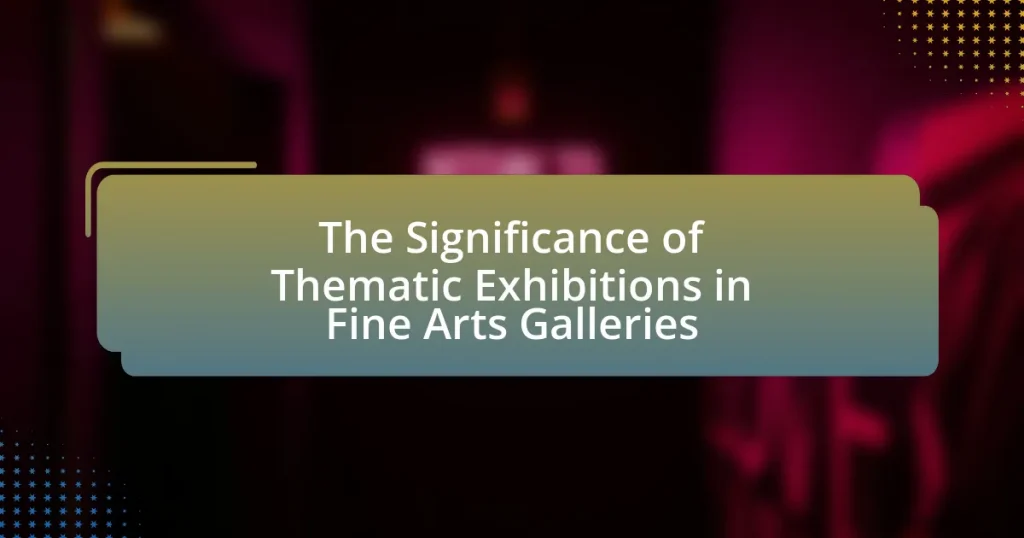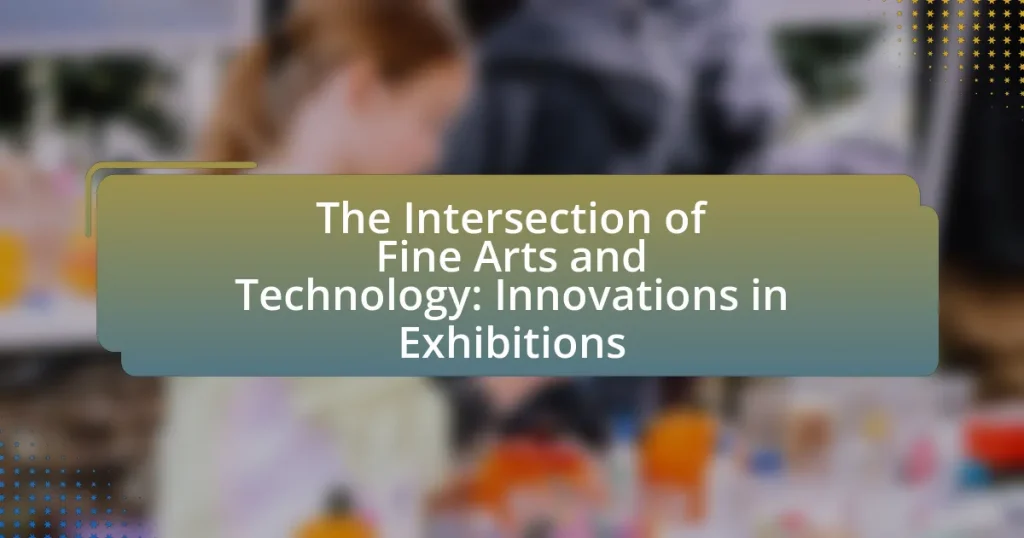The article examines the significant influence of social media on fine arts gallery exhibitions, highlighting how platforms like Instagram and Facebook enhance visibility and audience engagement. It discusses the transformation of promotional strategies, the effectiveness of various social media platforms, and the methods galleries use to measure the impact of social media on attendance. Additionally, the article explores the importance of social media for contemporary artists, the challenges galleries face, and the evolving themes and content in exhibitions driven by social media trends. Best practices for effective social media management and audience engagement are also outlined, emphasizing the role of user-generated content and analytics in shaping successful gallery strategies.
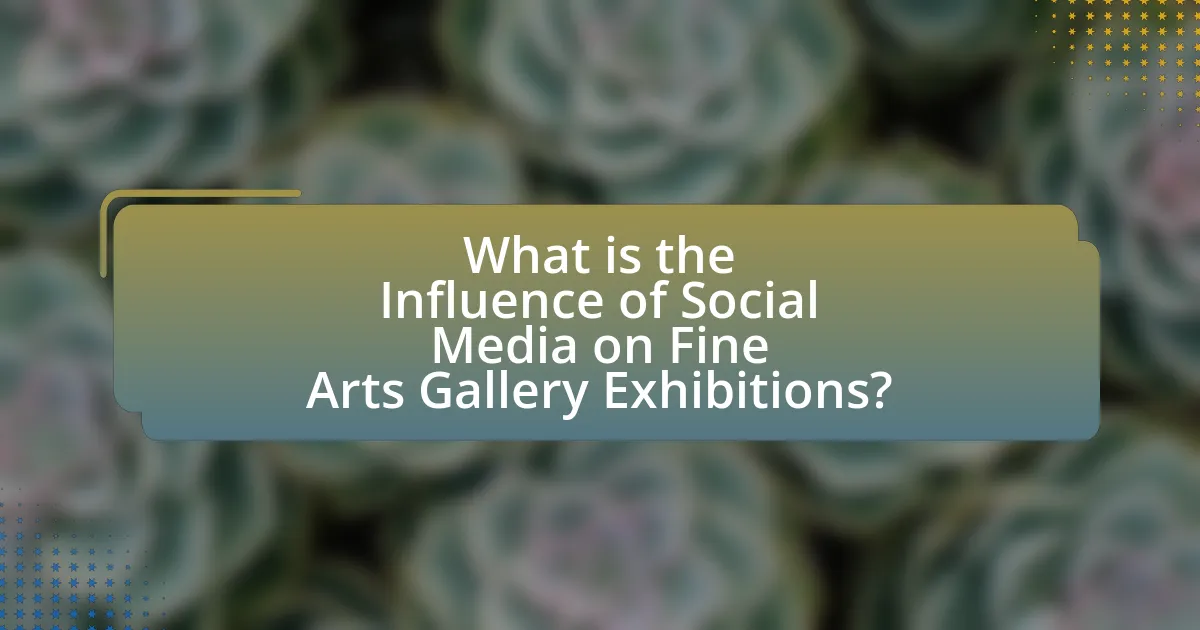
What is the Influence of Social Media on Fine Arts Gallery Exhibitions?
Social media significantly influences fine arts gallery exhibitions by enhancing visibility and audience engagement. Galleries utilize platforms like Instagram and Facebook to showcase artworks, promote events, and connect with a broader audience, leading to increased foot traffic and sales. For instance, a study by the National Endowment for the Arts found that 72% of art galleries reported a rise in attendance due to social media marketing efforts. Additionally, social media allows for real-time feedback and interaction, enabling galleries to adapt their exhibitions based on audience preferences and trends. This dynamic interaction fosters a sense of community and encourages participation in the arts, ultimately transforming how exhibitions are curated and experienced.
How has social media changed the way galleries promote exhibitions?
Social media has transformed how galleries promote exhibitions by enabling direct engagement with audiences and expanding their reach. Galleries now utilize platforms like Instagram and Facebook to showcase artworks, share behind-the-scenes content, and interact with potential visitors in real-time. This shift allows for targeted marketing strategies, as galleries can analyze audience demographics and preferences through social media analytics. According to a 2021 survey by the Art Market Research, 70% of galleries reported increased visitor numbers due to social media promotion, highlighting its effectiveness in attracting diverse audiences.
What platforms are most effective for gallery promotion?
Instagram and Facebook are the most effective platforms for gallery promotion. Instagram’s visual-centric design allows galleries to showcase artwork through high-quality images and videos, attracting a younger audience; as of 2023, 67% of users are aged 18-29. Facebook, with its extensive user base and event features, enables galleries to reach a broader demographic and promote exhibitions effectively. According to a survey by the Pew Research Center, 69% of adults in the U.S. use Facebook, making it a vital tool for event promotion and community engagement.
How do galleries measure the impact of social media on attendance?
Galleries measure the impact of social media on attendance primarily through analytics tools that track engagement metrics and visitor data. These tools analyze social media interactions, such as likes, shares, and comments, alongside attendance figures to establish correlations. For instance, a gallery may observe an increase in attendance following a targeted social media campaign, using platforms like Facebook Insights or Instagram Analytics to quantify the reach and engagement of their posts. Additionally, galleries often conduct surveys at the entrance to gather data on how visitors learned about the exhibition, allowing them to directly link social media efforts to attendance outcomes. This method provides concrete evidence of social media’s influence on visitor numbers.
Why is social media important for contemporary artists and galleries?
Social media is crucial for contemporary artists and galleries because it provides a platform for direct engagement with audiences and potential buyers. This engagement allows artists to showcase their work to a global audience, significantly increasing visibility and reach. According to a 2021 survey by Art Basel and UBS, 70% of collectors reported discovering new artists through social media platforms, highlighting its role in expanding market opportunities. Additionally, social media facilitates real-time interaction, enabling artists and galleries to build communities, receive immediate feedback, and promote exhibitions effectively, which is essential in a competitive art market.
What role does social media play in artist visibility?
Social media significantly enhances artist visibility by providing a platform for direct engagement with audiences and potential buyers. Artists can showcase their work, share their creative processes, and connect with followers, which increases their reach and exposure. According to a 2021 survey by the National Endowment for the Arts, 70% of artists reported that social media was crucial for promoting their work and gaining new audiences. This direct interaction fosters community building and can lead to increased opportunities for exhibitions and sales, demonstrating the vital role social media plays in the contemporary art landscape.
How does social media facilitate audience engagement for galleries?
Social media facilitates audience engagement for galleries by providing platforms for direct interaction and content sharing. Galleries can showcase their exhibitions, share behind-the-scenes content, and host live events, which encourages audience participation. For instance, a study by the Pew Research Center found that 69% of adults in the U.S. use social media, making it a vital tool for reaching a broad audience. Additionally, galleries can utilize features like polls, comments, and shares to foster community discussions and feedback, enhancing the overall visitor experience and connection to the art.
What challenges do galleries face when using social media?
Galleries face several challenges when using social media, including maintaining consistent engagement, managing negative feedback, and navigating algorithm changes. Consistent engagement is crucial for building an audience, yet galleries often struggle to produce regular, high-quality content that resonates with followers. Negative feedback can arise from public posts, which may deter potential visitors or damage reputation if not handled effectively. Additionally, social media platforms frequently update their algorithms, impacting visibility and reach, making it difficult for galleries to maintain their audience without investing in paid promotions. These challenges highlight the complexities galleries encounter in leveraging social media effectively for exhibitions.
How can galleries overcome negative feedback on social media?
Galleries can overcome negative feedback on social media by actively engaging with critics and addressing their concerns directly. This approach fosters a sense of community and demonstrates that the gallery values feedback. For instance, responding promptly to comments, offering clarifications, and showing willingness to improve can mitigate negative perceptions. Research indicates that 70% of consumers are more likely to support a brand that responds to their feedback, highlighting the importance of engagement in maintaining a positive reputation. By implementing these strategies, galleries can transform negative interactions into opportunities for dialogue and improvement.
What are the risks of relying too heavily on social media for promotion?
Relying too heavily on social media for promotion poses several risks, including diminished audience engagement, potential misinformation, and over-reliance on algorithms. When galleries depend primarily on social media, they may experience reduced direct interaction with their audience, as personal connections often foster deeper engagement. Additionally, the spread of misinformation can occur rapidly on these platforms, potentially damaging a gallery’s reputation if incorrect information about exhibitions circulates. Furthermore, social media algorithms can change unpredictably, leading to decreased visibility for posts and promotions, which can significantly impact attendance and sales. According to a 2021 study by the Pew Research Center, 64% of Americans believe that social media platforms have a negative impact on the way news is reported, highlighting the potential pitfalls of relying on these channels for accurate promotion.
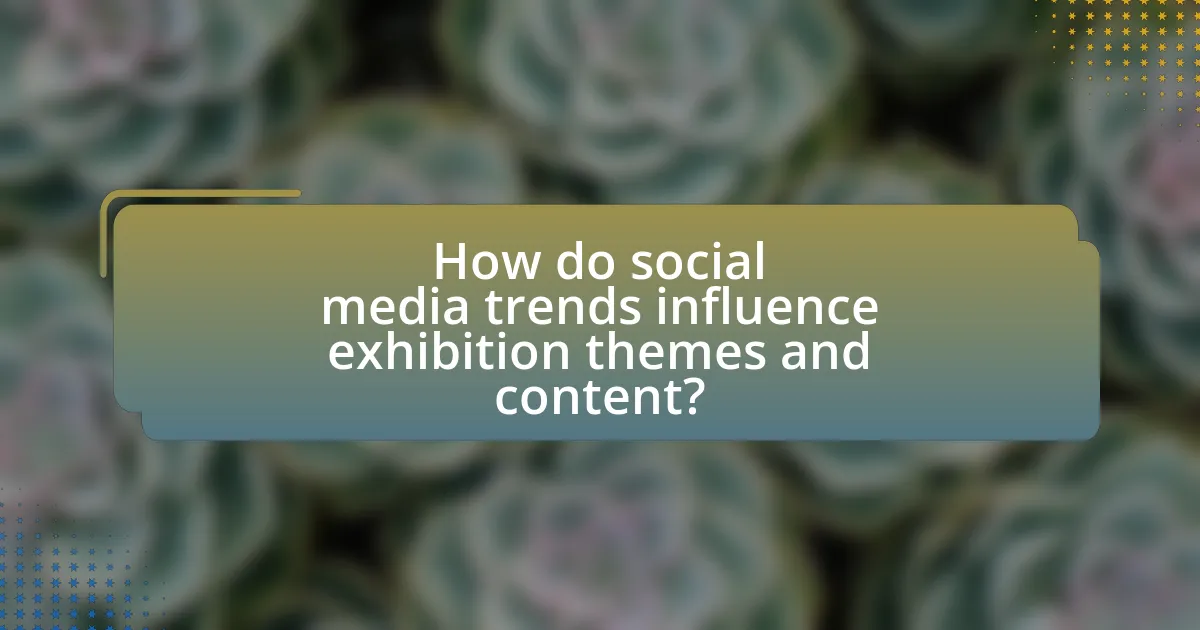
How do social media trends influence exhibition themes and content?
Social media trends significantly influence exhibition themes and content by shaping public interests and facilitating real-time feedback. For instance, galleries often analyze trending hashtags and viral content to curate exhibitions that resonate with current cultural conversations, ensuring relevance and engagement. A study by the Pew Research Center indicates that 69% of adults in the U.S. use social media, highlighting its role in shaping collective tastes and preferences. Consequently, exhibitions that align with popular social media themes, such as sustainability or social justice, attract larger audiences and foster community dialogue.
What current trends in social media are shaping gallery exhibitions?
Current trends in social media shaping gallery exhibitions include the rise of immersive experiences, increased audience engagement through interactive content, and the use of platforms like Instagram for visual storytelling. Immersive experiences, such as virtual reality and augmented reality installations, allow galleries to attract tech-savvy audiences and create memorable interactions. Increased audience engagement is facilitated by interactive content, such as polls and live Q&A sessions, which encourage participation and foster community. Additionally, Instagram’s emphasis on visual content enables galleries to showcase artworks effectively, reaching wider audiences and enhancing visibility. According to a 2022 survey by Art Basel, 70% of galleries reported that social media significantly impacted their marketing strategies, demonstrating its crucial role in contemporary exhibition practices.
How do viral trends affect the selection of artworks for exhibitions?
Viral trends significantly influence the selection of artworks for exhibitions by prioritizing pieces that resonate with current social media interests and audience engagement. Galleries often curate exhibitions that align with trending topics to attract larger audiences, as seen in the rise of immersive installations and interactive art that gain traction online. For instance, the popularity of specific artists or styles can surge due to viral posts, leading galleries to feature these works prominently to capitalize on the heightened public interest. This phenomenon is supported by data indicating that exhibitions featuring trending artworks often experience increased attendance and media coverage, demonstrating the direct impact of social media trends on exhibition choices.
What themes are gaining popularity due to social media influence?
Themes gaining popularity due to social media influence include mental health awareness, sustainability, and diversity in representation. Social media platforms have amplified discussions around mental health, leading artists to create works that reflect personal struggles and societal issues. The theme of sustainability has emerged as artists increasingly focus on eco-friendly practices and materials, responding to the growing concern for environmental issues. Additionally, diversity in representation has gained traction, with artists highlighting underrepresented voices and cultures, driven by social media campaigns advocating for inclusivity. These themes resonate with audiences, as evidenced by increased engagement and support for exhibitions that feature such topics.
How do galleries adapt their content to fit social media formats?
Galleries adapt their content to fit social media formats by creating visually engaging, concise posts that highlight key aspects of their exhibitions. This adaptation often involves using high-quality images, short videos, and interactive elements like polls or stories to capture audience attention quickly, as social media users typically scroll rapidly through content. For instance, galleries may utilize Instagram’s emphasis on visuals by posting striking artwork images accompanied by brief descriptions or artist insights, aligning with the platform’s aesthetic focus. Additionally, galleries often tailor their content to specific platform algorithms, optimizing post timing and engagement strategies to increase visibility and interaction, which is crucial given that platforms like Facebook and Instagram prioritize content that generates user engagement.
What types of content resonate most with social media audiences?
Visual content, particularly images and videos, resonates most with social media audiences. Research indicates that posts featuring visuals receive 94% more views than those without, highlighting the importance of engaging imagery in capturing attention. Additionally, short-form videos, such as those on platforms like TikTok and Instagram Reels, have shown to drive higher engagement rates, with users spending an average of 52 minutes daily on video content. This trend underscores the effectiveness of dynamic and visually appealing content in fostering interaction and sharing among social media users.
How can galleries create shareable content for their exhibitions?
Galleries can create shareable content for their exhibitions by leveraging high-quality visuals, engaging storytelling, and interactive elements. High-quality images and videos of artworks attract attention and encourage sharing on platforms like Instagram and Facebook, where visual content thrives. Engaging storytelling about the artists and the themes of the exhibition can resonate with audiences, prompting them to share their experiences. Additionally, incorporating interactive elements, such as virtual tours or augmented reality features, enhances user engagement and increases the likelihood of sharing. Research indicates that posts with compelling visuals receive 94% more views than text-only posts, underscoring the importance of visual content in driving shares.
What is the impact of user-generated content on gallery exhibitions?
User-generated content significantly enhances gallery exhibitions by increasing audience engagement and expanding reach. This content, often shared on social media platforms, allows visitors to contribute their perspectives and experiences, fostering a sense of community around the exhibition. For instance, a study by the Pew Research Center found that 72% of adults use social media, which amplifies the visibility of gallery events and attracts diverse audiences. Additionally, user-generated content can provide galleries with valuable feedback and insights into visitor preferences, enabling them to tailor future exhibitions more effectively.
How can galleries encourage visitors to share their experiences online?
Galleries can encourage visitors to share their experiences online by creating engaging social media campaigns and providing incentives for sharing. For instance, galleries can establish unique hashtags for exhibitions, making it easy for visitors to tag their posts and connect with the gallery’s online presence. Additionally, offering discounts or exclusive content in exchange for social media posts can motivate visitors to share their experiences. Research indicates that 79% of people say user-generated content highly impacts their purchasing decisions, highlighting the importance of encouraging visitors to share their experiences. By fostering a community around their exhibitions and actively engaging with visitors online, galleries can enhance their visibility and reach.
What are the benefits of featuring user-generated content in exhibitions?
Featuring user-generated content in exhibitions enhances audience engagement and fosters community involvement. By incorporating content created by visitors, galleries create a more interactive experience that resonates with attendees, encouraging them to feel a personal connection to the exhibition. Research indicates that exhibitions featuring user-generated content can increase visitor satisfaction by up to 30%, as participants feel their contributions are valued and recognized. This approach not only diversifies the content presented but also attracts a wider audience, as individuals are more likely to share their experiences on social media, amplifying the exhibition’s reach and visibility.
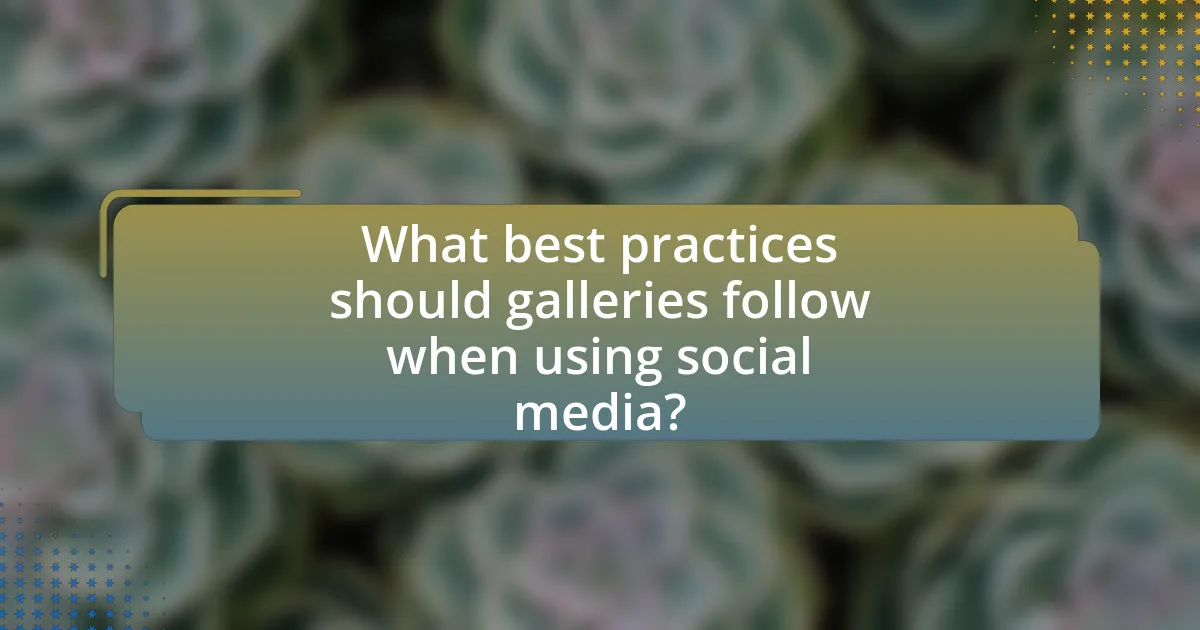
What best practices should galleries follow when using social media?
Galleries should prioritize consistent branding and engagement when using social media. Consistent branding ensures that the gallery’s identity is recognizable across platforms, which can enhance audience loyalty and trust. Engaging content, such as behind-the-scenes looks, artist interviews, and interactive posts, fosters community and encourages audience interaction. According to a study by the Pew Research Center, 69% of adults in the U.S. use social media, indicating a significant opportunity for galleries to reach potential visitors and collectors. Additionally, galleries should utilize analytics tools to track engagement metrics, allowing them to refine their strategies based on audience preferences and behaviors.
How can galleries effectively engage with their audience on social media?
Galleries can effectively engage with their audience on social media by creating interactive content that encourages participation and dialogue. This includes hosting live Q&A sessions, sharing behind-the-scenes footage, and utilizing polls or quizzes related to current exhibitions. Research indicates that interactive posts generate 50% more engagement than static content, highlighting the importance of fostering a two-way communication channel. Additionally, galleries should leverage user-generated content by encouraging visitors to share their experiences and artworks, which can enhance community involvement and increase visibility.
What strategies can galleries use to build a loyal online community?
Galleries can build a loyal online community by actively engaging with their audience through consistent content sharing, interactive social media campaigns, and personalized communication. Regularly posting high-quality images and videos of exhibitions, artist interviews, and behind-the-scenes content fosters a connection with followers. Interactive campaigns, such as live Q&A sessions or virtual tours, encourage participation and create a sense of belonging. Personalized communication, including responding to comments and messages, enhances relationships and loyalty. According to a study by the Pew Research Center, 69% of adults in the U.S. use social media, indicating a significant opportunity for galleries to reach and engage potential community members effectively.
How often should galleries post to maintain audience interest?
Galleries should post at least 3 to 5 times per week to maintain audience interest. This frequency allows galleries to stay relevant in the fast-paced social media environment, where consistent engagement is crucial. Research indicates that brands that post regularly see higher engagement rates; for instance, a study by HubSpot found that companies posting 16 or more times per month receive 3.5 times more traffic than those posting less frequently. Therefore, maintaining a posting schedule of several times a week can effectively keep the audience engaged and informed about exhibitions and events.
What tools and resources can galleries utilize for social media management?
Galleries can utilize tools such as Hootsuite, Buffer, and Sprout Social for effective social media management. Hootsuite allows galleries to schedule posts across multiple platforms, track engagement metrics, and manage interactions in one dashboard, which enhances their online presence. Buffer offers similar scheduling capabilities and provides analytics to optimize posting times and content types based on audience engagement. Sprout Social includes robust reporting features that help galleries analyze their social media performance and adjust strategies accordingly. These tools are widely recognized in the industry for their effectiveness in streamlining social media efforts and improving audience engagement.
What analytics tools are available to track social media performance?
Analytics tools available to track social media performance include Google Analytics, Hootsuite, Sprout Social, Buffer, and Facebook Insights. Google Analytics provides insights into website traffic driven by social media, while Hootsuite and Sprout Social offer comprehensive social media management and analytics features, allowing users to monitor engagement and audience demographics. Buffer focuses on scheduling posts and analyzing their performance across various platforms. Facebook Insights specifically tracks engagement metrics for content shared on Facebook. These tools are widely used in the industry, with reports indicating that over 70% of marketers utilize analytics tools to measure social media effectiveness.
How can galleries use scheduling tools to optimize their social media presence?
Galleries can use scheduling tools to optimize their social media presence by planning and automating their posts to ensure consistent engagement with their audience. By utilizing these tools, galleries can analyze the best times to post based on audience activity, allowing them to reach more followers effectively. For instance, studies show that posts made during peak engagement times can increase visibility and interaction rates by up to 50%. Additionally, scheduling tools enable galleries to maintain a steady flow of content, which is crucial for keeping their audience informed about exhibitions, events, and artist features, ultimately enhancing their online presence and community engagement.
What are some common mistakes galleries make on social media?
Galleries commonly make mistakes on social media by failing to engage their audience effectively. This includes posting infrequently, which can lead to decreased visibility and follower engagement. Additionally, galleries often neglect to utilize visual content optimally; high-quality images of artwork are essential for attracting attention, yet many galleries post low-resolution images or irrelevant content. Another frequent error is not responding to comments or messages, which can create a perception of inaccessibility and diminish community building. Furthermore, galleries sometimes lack a clear brand voice or strategy, resulting in inconsistent messaging that confuses followers. Lastly, failing to analyze social media metrics prevents galleries from understanding what content resonates with their audience, hindering their ability to improve future posts.
How can galleries avoid pitfalls in their social media strategy?
Galleries can avoid pitfalls in their social media strategy by establishing clear objectives and understanding their target audience. By defining specific goals, such as increasing engagement or promoting exhibitions, galleries can tailor their content effectively. Research indicates that 73% of marketers believe that social media marketing has been effective for their business, highlighting the importance of strategic planning. Additionally, galleries should regularly analyze their performance metrics to identify what works and what doesn’t, allowing for adjustments in real-time. This data-driven approach ensures that galleries remain relevant and can effectively engage their audience, thus minimizing the risk of miscommunication or ineffective outreach.
What lessons can galleries learn from successful social media campaigns?
Galleries can learn the importance of audience engagement and storytelling from successful social media campaigns. Engaging content that resonates with the audience fosters community and encourages sharing, which can significantly increase visibility. For instance, campaigns like the #MuseumMomentofZen by the Getty Museum effectively used visually appealing content to engage users, resulting in increased follower counts and interactions. Additionally, successful campaigns often utilize analytics to understand audience preferences, allowing galleries to tailor their content for maximum impact. This data-driven approach can lead to higher attendance at exhibitions and events, as evidenced by the increased visitor numbers reported by institutions that actively engage on social media platforms.



